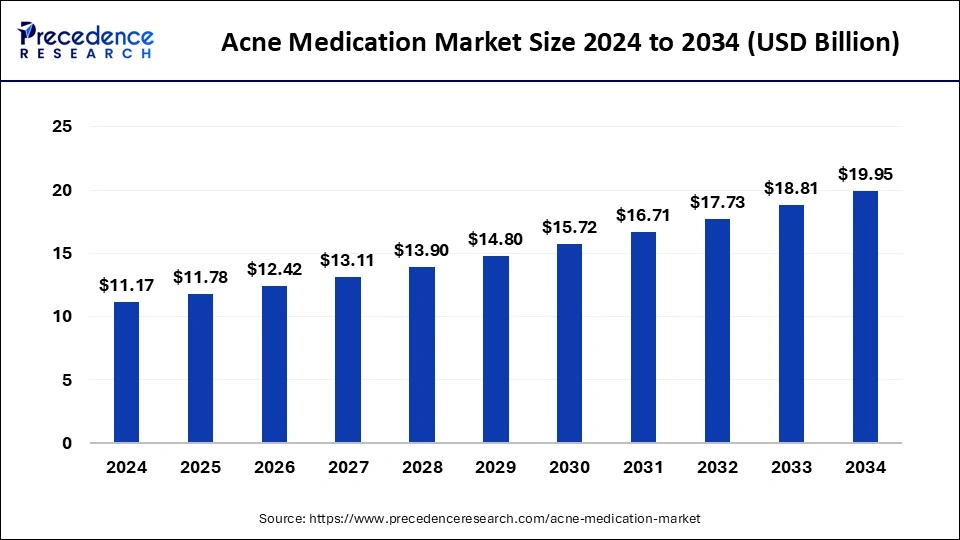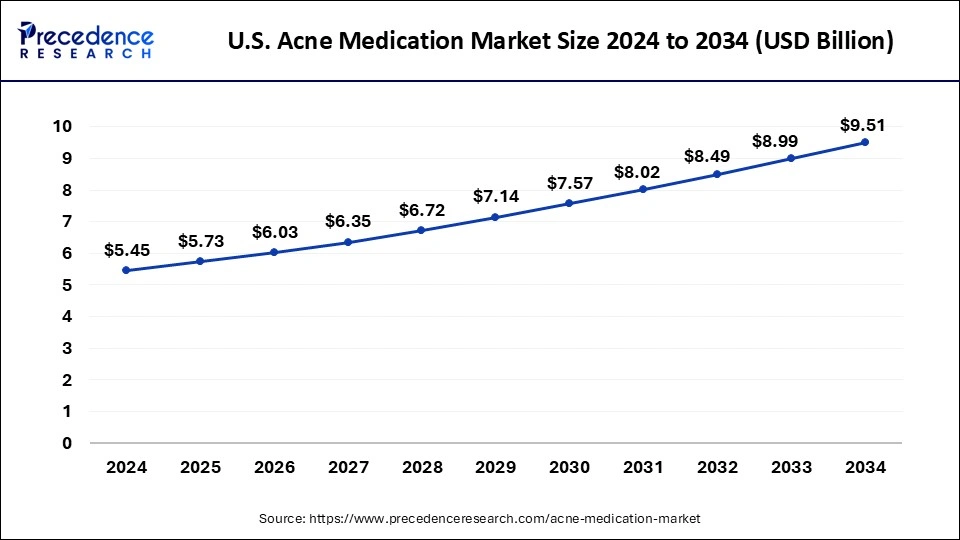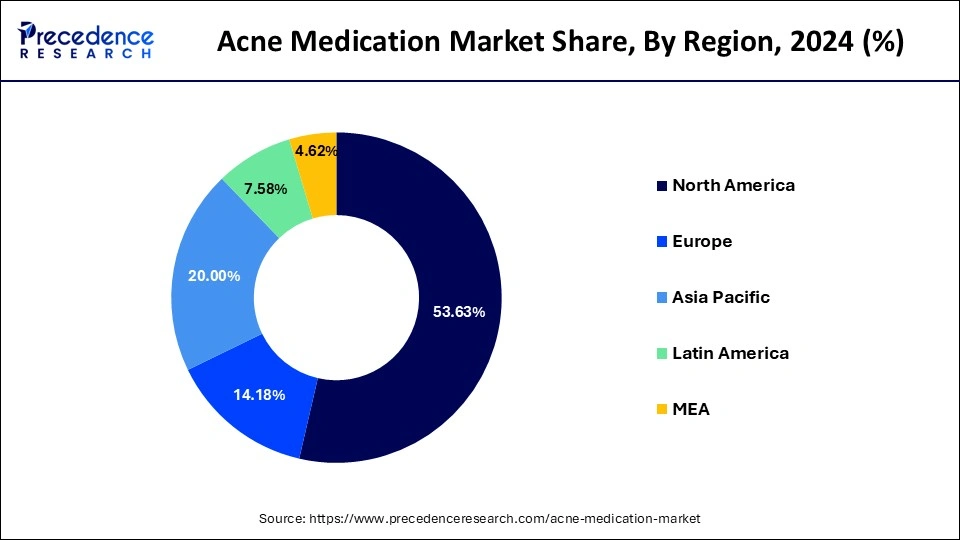List of Contents
What is Acne Medication Market Size?
The global acne medication market size accounted for USD 11.78 billion in 2025 and is predicted to increase from USD 12.42 billion in 2026 to approximately USD 19.95 billion by 2034, expanding at a CAGR of 6.00% from 2025 to 2034.

Market Highlights
- North America dominated the acne medication market with the largest share of 53.63% in 2024.
- Asia Pacific is expected to witness significant growth in the market during the forecast period.
- By product, the antibiotics segment dominated the market in 2024.
- By product, the retinoid segment is expected to grow at a notable rate in the market during the forecast period.
- By routes of administration, the topical segment held the largest share of the market in 2024.
- By route of administration, the oral segment is expected to grow at the fastest rate in the market during the anticipated period.
- By age group, the 18-44 segment dominated the market with significant revenue in 2024.
- By distribution channel, the retail and online segment is expected to witness a significant rate of growth during the forecast period.
Market Overview
The acne medication market refers to the pharmaceutical and over-the-counter (OTC) products designed to treat and manage acne, a common skin condition characterized by the presence of pimples, blackheads, whiteheads, and inflammation on the skin. Acne medications encompass a wide range of topical and oral treatments, including prescription medications, over-the-counter creams and gels, cleansers, and spot treatments.
Adapalene is one of the types of medication that is used in the treatment of acne problems. It comes in a gel or cream formulation. Benzoyl peroxide is another type of acne medication that destroys or reduces the amount of bacteria in acne. Changing lifestyles, sleeping and eating habits, higher consumption of junk and oily food, rising environmental pollution, and bad weather conditions are collectively impacting human health and skin, which results in increasing skin diseases like acne that boost the demand for acne medication and drive the growth of the acne medication market.
Acne Medication Market Growth Factors
- The increasing cases of acne problems in the younger population are driving the market's growth. Changes in the young population's lifestyle and changing environmental conditions highly contribute to skin allergies, acne, and other skin-related issues that may accelerate the demand for the medicines that drive the growth of the acne medication market.
- The rising innovations in the healthcare market and skin treatment segment are boosting the growth of the market over the forecast period.
- The rising concern about skin issues in the population and the demand for effective acne treatment is driving the growth of the market.
- The increasing disposable income and the rising expenditure on healthcare and beauty products are driving the growth of the market.
- The increasing urbanization and the higher adoption of unhealthy lifestyles are boosting the growth of the acne medication market.
Acne Medication MarketTrends
- Rising Acne Awareness More adolescents and young adults are seeking acne treatments due to hormonal changes, lifestyle factors, and increasing awareness of skincare.
- Popularity of Over-the-Counter Treatments Consumers increasingly prefer OTC products like salicylic acid and benzoyl peroxide for convenience and self-care without needing prescriptions.
- Innovative Treatments New topical and oral medications, including combination therapies and microbiome-based treatments, are being developed to improve effectiveness and reduce side effects.
- Digital and Personalized Support Tele-dermatology and skincare apps help users choose the right treatments, track progress, and reduce the need for in-person clinic visits.
- Focus on Skin-Friendly Formulations Consumers are demanding milder, “clean,” and sensitive-skin-friendly products that treat acne while maintaining overall skin health.
- Growth in Emerging Markets Rising disposable incomes, improved access to dermatological care, and expanding retail and online channels are driving growth in emerging regions.
- Shift in Distribution Channels E-commerce, online pharmacies, and direct-to-consumer sales are becoming more important, increasing accessibility and speeding up the adoption of new treatments.
- Sustainability and Holistic Skin Health Acne medications are increasingly designed to support long-term skin wellness and align with broader skincare and wellness trends.
Market Outlook
- Industry Growth Overview: Due to the rising skin health awareness, the high incidence of acne in all age groups, and easier access to both over-the-counter and prescription treatments, the market for acne medication is expanding steadily. The need for more efficient and focused treatments is also being driven by formulation innovation, such as combination therapies, topical solutions, and microbiome-based therapies.
- Sustainability Trends: In the market for acne medications, sustainability is becoming more crucial. Companies are concentrating on clean, skin-friendly formulas that contain more natural ingredients and fewer harsh chemicals. The use of recyclable, biodegradable, or reduced waste packaging is growing in order to satisfy consumer demand for environmentally friendly goods.
- Major Investors: With venture capital and private equity concentrating on startups providing cutting-edge treatments, digital dermatology platforms, and at-home care solutions, investment in the acne medication industry is growing. Businesses creating cutting-edge delivery methods, tech-enabled treatment platforms, and user-friendly acne remedies are especially appealing to investors.
Market Scope
| Report Coverage | Details |
| Market Size in 2025 | USD 11.78 Billion |
| Market Size in 2026 | USD 12.42 Billion |
| Market Size by 2034 | USD 19.95 Billion |
| Growth Rate from 2025 to 2034 | CAGR of 6.00% |
| Base Year | 2024 |
| Forecast Period | 2025 to 2034 |
| Segments Covered | Product, Routes of Administration, Age-Group, and Distribution Channel, and Region |
| Regions Covered | North America, Europe, Asia-Pacific, Latin America, and Middle East & Africa |
Market Dynamics
Drivers
The rising cases of acne in the younger population
The rising cases of acne in the younger population, mostly teenagers, are driving the growth of the acne medication market. The increasing urbanization and, changing lifestyles, and increasing pollution levels are highly impacting the skin of humans and causing allergies, pimples, blackheads, which are driving the demand for effective medication for the treatment of such conditions, which is driving the growth of the market. Additionally, the rising availability and the innovative launch of the latest treatment products, such as retinoids, antibiotics, and others, are influencing the growth of the market.
Restraint
Side effects
Similar to several other medications prescribed for cosmetic and medical use, acne medications result in a wide range of adverse reactions ranging from mild local irritation to systemic side effects such as liver dysfunctions. Depending on individual cases has been reported wherein side effects such as vomiting, nausea, or diarrhea were reported on the use of acne medication. This can hamper the growth of the acne medication market.
Opportunity
Increasing investment in skin and beauty products
The increasing demand for maintaining facial aesthetics in the population is driving the growth of major beauty and personal care companies that make lifestyle products for the generation that faces skin challenges like acne, pimples, dull skin, blackheads, etc. The increase in the beauty industry and the rising expenditure on skin treatment and maintenance are boosting the growth of the market. The increasing investments in research and development programs for the innovation of new products or treatments associated with acne are driving future opportunities for the acne medication market.
Segment Insights
Product Insights
The antibiotics segment dominated the acne medication market in 2024. The rising adoption of antibiotics as a treatment for acne due to their higher efficiency is drives the growth of the antibiotics segment. Antibiotics come in two types: topical and oral. Antibiotics are highly used in acne treatment because they help to reduce the amount of bacteria, inflammation, and swelling and minimize the risk of scars. Tetracycline and erythromycin are antibiotics that can help reduce the extreme pain of acne, which is related to bacteria on the skin. Thus, the higher adoption of antibiotics in acne treatment drives the growth of the antibiotics segment.
The retinoid segment is expected to grow at a notable rate in the acne medication market during the forecast period. The growth of the segment is expected to increase due to the rising demand for retinoids to help reduce mild acne and enhance the skin's appearance. Retinol generally comes in gels, serums, lotions, wipes, and creams. Retinol is commonly found in every kind of skincare product, including anti-acne and anti-aging products. Retinol is applied to the skin once per day after cleaning the face for 20 or 30 minutes. There are some other benefits associated with the use of retinol, such as anti-aging, minimizing fine lines and wrinkles, reducing pigmentation, increasing skin elasticity, and enhancing skin tone and texture. All these factors are contributing to the demand for retinol in the acne medication market.
Formulation Insights
The topical segment held the largest share of the acne medication market in 2024. The growth of the segment is attributed to the rising adoption of topical solutions due to their easy availability and soothing nature. Topical retinoids like adapalene or tretinoin are considered the most effective method for the treatment of comedonal acne. Topical antibiotics like azelaic acid and benzoyl peroxide are used in the inflammatory condition of acne. Topical treatments are considered the sole treatment for acne in many patients and are used as part of the therapeutic regimen.
The oral segment is expected to grow at the fastest pace in the acne medication market during the anticipated period. The rising adoption of oral administration of acne medication due to its effectiveness and treatment within the body is driving the demand for the oral administration of the drug. Oral medicine is prescribed by the doctor in the case of moderate to severe acne problems, and acne does not respond to the topical treatment. The segment includes oral antibiotics, accutane (isotretinoin), oral contraceptives, and Aldactone (spironolactone). In which oral contraceptives and Aldactone are used in acne related to the menstrual cycles.
Distribution Channel Insights
The retail and online segment is expected to witness a significant rise in the acne medication market during the forecast period. The growth of the segment is attributed to the rising adoption of online marketing by consumers due to better discount offers, convenience, and other benefits. The rising e-commerce platforms like Amazon, Walmart, etc., and the rising commercialization are boosting the growth of the segment. Additionally, the rise in urbanization and the increasing number of supermarkets and hypermarkets in urban areas are contributing to the expansion of the retail sector and fueling the growth of the market.
Regional Insights
U.S.Acne Medication Market Size and Growth 2025 to 2034
The U.S. acne medication market size is exhibited at USD 5.73 billion in 2025 and is projected to be worth around USD 9.51 billion by 2034, growing at a CAGR of 5.80% from 2025 to 2034.

North America led the market with the biggest market share of 53.63% in 2024. The region's expansion in the market is increasing due to the rising availability of the major beauty and skincare brands and the manufacturing industries in the United States and Canada. The rising investments in skincare products due to the intensive demand from the consumer are highly contributing to the growth of the market. The increase in the younger population, which is more likely to get affected by acne due to changing hormones, lifestyle, etc., is creating a significant growth in the sale of acne medication around the region, which accelerates the growth of the market across the region.

Asia Pacific is expected to witness the fastest rate of expansion in the acne medication market during the forecast period. The increasing population and majorly the younger population in India, China, and Japan are driving the demand for acne medication. The younger population, like teenagers and adults, are more likely to get acne due to lifestyle, urbanization, and rising pollution, which is highly impacting human health and skin and boosts the growth of the acne medication market. Additionally, the rising expenditure on healthcare and appearance is collectively contributing to the growth of the market.
The Asia Pacific acne medication market offers a wide range of products catering to various skin types, concerns, and preferences. From traditional herbal remedies to modern pharmaceutical formulations, consumers have access to a diverse array of acne treatment options, contributing to market dominance. Improvements in healthcare infrastructure, access to healthcare services, and availability of over-the-counter (OTC) acne medications contribute to market expansion in Asia Pacific. As healthcare systems become more accessible and healthcare professionals promote skincare awareness, individuals are more likely to seek treatment for acne.
Value Chain Analysis
- R&D: Companies are focusing on creating more effective and gentle acne treatments, including combination therapies and innovative delivery systems like microencapsulation and nanotechnology. These innovations aim to improve results while minimizing skin irritation.
- Distribution to Hospitals, Pharmacies: Hospital pharmacies and dermatology clinics are the primary distribution channels for prescription acne medications for moderate to severe cases, guaranteeing accurate diagnosis and expert advice. Over-the-counter products are readily accessible due to their widespread availability through retail pharmacies and online platforms.
- Patient Support and Services: Beyond medication, the market is focusing on patient support such as tele dermatology consultations, progress tracking apps, treatment adherence education programs, and side effect management advice. Both results and client satisfaction and enhanced by these services.
Acne Medication Market Companies
- Galderma S.A.
- Bausch Health Companies Inc.
- Mayne Pharma Group Limited
- Teva Pharmaceutical Industries Ltd
- Almirall Sa
- Glaxosmithkline Plc (Gsk)
- Pfizer Inc.
- Mylan N.V.
- Sun Pharmaceutical Industries Limited
- Johnson & Johnson
Recent Developments
- In February 2024, VA-based med spa gentle wellness center, “Fairfax,” launched the Morpheus8 skin resurfacing treatment for people who are suffering from scar tissue from dermatological disorders.
- In January 2024, Bausch Health Companies Inc. and Ortho Dermatologics, its dermatology business, introduces the CABTREO™ (clindamycin, adapalene, benzoyl peroxide) topical gel, 1.2%/0.15%/3.1% in the U.S. for the topical treatment of acne vulgaries for the 12 years and above age patients.
Segments Covered in the Report
By Formulation
- Topical
- Oral
By Product
- Retinoids
- Antibiotics
- Salicylic acid
- Benzoyl peroxide
- Azelaic acid
- Others
By Type
- Prescription
- OTC
By Acne Type
- Inflammatory Acne
- Non-Inflammatory Acne
By Distribution Channel
- Retail Stores
- Pharmacies & Drug Stores
- E-Commerce
By Region
- North America
- Europe
- Asia-Pacific
- Latin America
- Middle East and Africa
For inquiries regarding discounts, bulk purchases, or customization requests, please contact us at sales@precedenceresearch.com
Frequently Asked Questions
Ask For Sample
No cookie-cutter, only authentic analysis – take the 1st step to become a Precedence Research client



